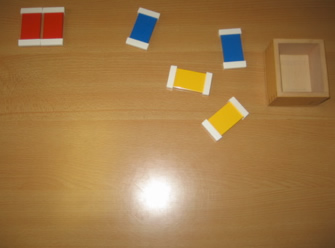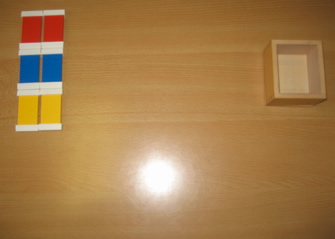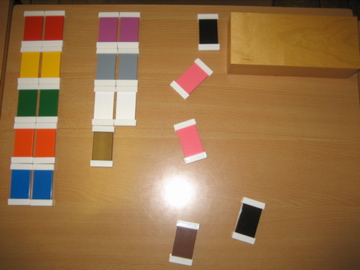|
3 boxes with lids containing color tablets:
6 tablets; a pair of each of the primary colors (red, yellow, blue). These are the most sharply contrasted colors.
22 tablets; a pair of each of the primary colors, the secondary colors (green, orange, purple), and also pink, brown, black, white, and grey.
:
63 tablets; 7 shades of 9 colors: red, yellow, blue, green, orange, purple, brown, pink, and grey.
Invite the child by telling him you have something to show him. Bring him over to the correct shelves and tell him we will be using the Color Tablets. Show the child how to carry the box with your two hands on opposite sides of the box with your fingers underneath the box and your thumbs over the top. Have the child bring the correct box and have him place it near the top right corner of the table. Have the child sit to your left and then you sit down in front of the box. Take off the lid using both hands and place it directly in front of the box. Pick up the box using both hands and place it carefully onto the lid.
- Take the red, yellow, and blue tablets (with their matching pair) out of the box with both hands and making it evident that you are aware of not touching the color part.
- Place each tablet randomly on the table next to the box.
- Pick up the box and place it behind the lid and then pick up the lid and replace in onto the box.
- Pick up one of the red tablets using your right thumb and index finger and holding the “frame” part of the tablet.
- Place it near the top of the table and isolated from the other tablets.
- Then tell the child, “ I’m looking for one just like it.”
- Choose the other red tablets and gently place it directly next to the first red tablet.
- Then pick up the yellow tablet and place it under the first red tablet.
- Ask the child, “Can you find the one just like it?”
- Match the yellow in the same way as the red.
- Place one of the blue tablets under the first yellow tablet.


Now that the child has had the introduction for Box 1, have him carry Box 2 over to the table and open the box as before.
- Take the red, yellow, blue, green, orange, and purple tablets (with their matching pair) out of the box with both hands and making it evident that you are aware of not touching the color part.
- Place each tablet randomly on the table next to the box.
- Pick up the box and place it behind the lid and then pick up the lid and replace in onto the box.
- Pick up one of the red tablets using your right thumb and index finger and holding the “frame” part of the tablet.
- Place it near the top of the table and isolated from the other tablets.
- Then ask the child to place the one that looks just like it next to it.
- Have the child choose the next color and place it directly under the first red tablet. Then you find its match.
- Have the child choose a color and then match it until all of the colors have been matched. (Show the child where to place the tablets in a new column once the first column is done.)
- Have the child close his eyes and tell him you are going to mix them up.
- Mix the tablets and place them all to the left of the box.
- Have the child match just as you had done in the presentation.
- Take out the other colors and place them randomly on the table to the left of the box.
- Have the child match these colors as well.
- When the child is finished working, have him replace the tablets back into the box, as he had done with Box 1, and then replace the box back onto the shelf.

Now that the child has had the introduction for Box 1 and 2, have him carry Box 3 over to the table and open the box as before.
- Take out one shade of color (so seven tablets of the same color but of different shades).
- Place each tablet randomly on the table next to the box.
- Close the box as done for the other boxes.
- Ask the child to find the two tablets that are the most different.
- Have the child place them next to each other (to see the contrast) and in isolation from the other tablets.
- Separate them but still keep them isolated from the others.
- Point to the darkest tablet (should be on the left) and tell the child that you are looking for one that is just a little different.
- Place the correct tablet directly to the right of the darkest shade.
- Point to this new tablet and ask the child, “ Can you find the one that is just a little different than this one?”
- Continue until you and the child have successfully arranged the shades in decreasing order.
- Have the child close his eyes and you mix up the tablets.
- Have the child arrange the shades in order as shown.
The child repeats the work as shown in the presentation using other graded colors until he has done all of the 9 shades.
The child takes out one set of colors to grade and you choose another set of contrasting color. Have the child grade them both. Mix up the tablets and repeat. Continue until the child has graded every two combinations possible.
Place two mats next to each other. Place the disk in the center. Take the darkest of each color and place it horizontally around the disk. Grade each color outwards to create a “Star Burst”.
No Game
|
Matching at a distance
Matching to the environment
|
Matching to the environment
Grading from an extreme
Grading from a midpoint |
Names of the colors (given after the child can pair box 2 without hesitation).
After the child can grade Box 3: dark and light and later the comparatives (darker and lighter) and the superlatives (darkest and lightest).
| No Language |
Three Period Lesson for Naming:
|
| Step 1: |
Choose one of each of the primary colors.
Name the colors clearly and repeat 2-4 times.
Have the child close his eyes and you mix the colors up.
|
| Step 2: |
Ask the child to point to the color you ask for.
Ask the child to give you a specific color.
Ask the child to place a specific color in a specific spot.
|
| Step 3: |
Ask the child, “What is this?”
Ask the child the names of all of the colors.
Mix up the colors and ask again.
|
Add in secondary colors: |
| Step 1: |
Quickly check for understanding of the primary colors.
Give the names of the new colors repeatedly as above.
|
| Step 2: |
Check for the child’s recognition of the names of the colors as done in Step 2 above.
|
| Step 3: |
Ask for the names of all of the colors more than once.
|
Three Period Lesson for Grading: Positives
|
Have the child take out any shade of one color.
Have the child grade the color from darkest to lightest.
Mix up the tablets.
Choose two tablets of contrasting shades but not the extremes. |
| Step 1: |
In a clear voice name the correct one as dark and the
other as light.
Repeat their names.
Change one or two of the tablets so the relationship changes and name them again.
|
| Step 2: |
Check for the name recognition by asking the child to show you a dark or light.
Change one of the tablets and ask for a dark or light.
|
| Step 3: |
Ask the child for the names.
Change the tablets and ask again.
|
| Three Period Lesson for Grading: Comparative |
Have the child take out any shade of one color.
Have the child grade the color from darkest to lightest.
Mix up the tablets.
Choose two tablets of contrasting shades but not the extremes. |
| Step 1: |
In a clear voice name the correct one as dark and the other as darker.
Repeat their names.
Change one or two of the tablets so the relationship changes and name them again.
|
| Step 2: |
Check for the name recognition by asking the child to show you a dark or darker.
Change one of the tablets and ask for a dark or darker.
|
| Step 3: |
Ask the child for the names.
Change the tablets and ask again.
|
Three Period Lesson for Grading: Superlative |
Have the child take out any shade of one color.
Have the child grade the color from darkest to lightest.
Mix up the tablets.
Choose three tablets of contrasting shades. |
| Step 1: |
In a clear voice name the correct one as dark and another as darker. Add in the darkest and say, “Now this one is the darkest”.
Repeat their names.
Change one or two of the tablets so the relationship changes and name them again.
|
| Step 2: |
Check for the name recognition by asking the child to show you the darkest.
Change one of the tablets and ask for the darkest.
Add in a few more of the tablets and ask for the darkest. Remove that tablet and ask for the new darkest. Remove that one and repeat until you only have two left. Then ask for the darker.
|
| Step 3: |
Ask the child for the name of the darkest.
Change the tablets and ask again.
|
To provide the child with a key to orient himself in the world of color.
The child’s ability to discriminate color.
3 – 3 1/2 years for Box 1 and Box 2
3 1/2 – 4 1/2 year for Box 3
Share your experiences in the
| 
